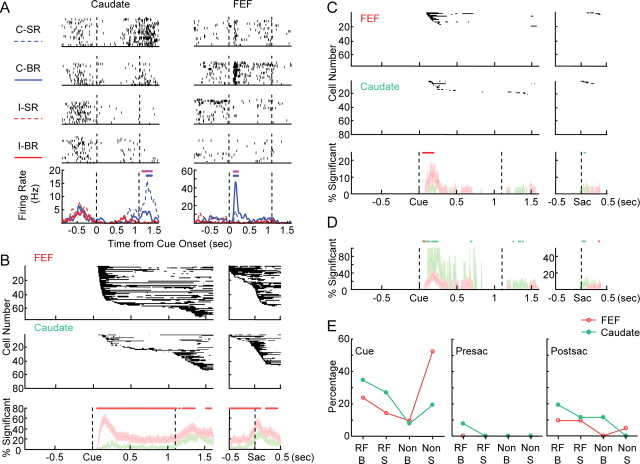Figure 2.
Cue position selectivity and reward modulation in one cue position. A, Examples of neural activity showing cue position selectivity and reward modulation in one cue position. Rasters were shown for the four conditions in the following order: contralateral cue–small reward (C-SR), contralateral cue–big reward (C-BR), ipsilateral cue–small reward (I-SR), and ipsilateral cue–big reward (I-BR). Dashed lines indicate cue onset and “go” signal, respectively. The bottom panel shows the spike density functions for all four conditions. Magenta bars indicate periods of response with significant cue position selectivity. Blue bars indicate periods of response with significant reward modulation for the contralateral cue position. B, Population data for cue position selectivity. The top panel shows the significance maps for FEF neurons (n = 75) aligned to cue onset and saccade onset, respectively. The middle panel shows the significance maps for caudate neurons (n = 79). Black pixels indicate the time bins with statistically significant modulation. Data from a single cell are presented as a row of pixels. Cells are sorted according to the earliest time of significant modulation. The bottom panel shows the percentage of cells with significant modulation at every 1 ms time bin. Red, FEF; green, caudate. Lightly shaded areas are estimates of 95% confidence intervals. Red dots on top indicate time bins with significantly greater percentage for FEF than for caudate. C, Population data for reward modulation in one cue position. The layout is the same as B. Red and green dots indicate time bins with significantly greater percentage for FEF and for caudate, respectively. D, Percentage of cells with significant reward modulation in one cue position, normalized by the number of cells with significant cue position selectivity. Red and green dots indicate time bins with significantly greater percentage for FEF and for caudate, respectively. E, Frequency of occurrence for four types of reward modulation in one cue position. RF, Preferred cue location; Non, nonpreferred cue location; B, larger activation in big-reward trials; S, larger activation in small-reward trials; Cue, 0–1 s after cue onset; Presac, 0.25–0 s before saccade onset; Postsac, 0–0.5 s after saccade onset.

